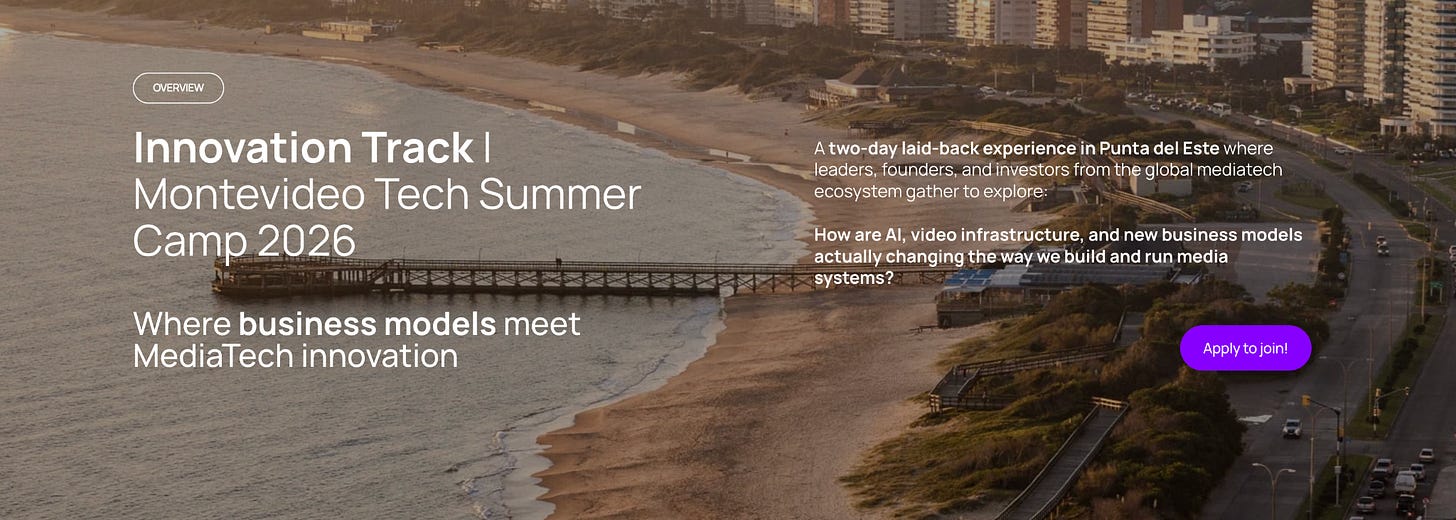Introducing the Innovation Track at Montevideo Tech Summer Camp
A focused room inside a much bigger experiment
Every January, Qualabs brings together people who like building things. Engineers. Designers. Open source contributors. Founders. Operators. The Summer Project runs for three months leading up to it, with distributed teams prototyping real tools in the open. Then everyone who can heads to Montevideo for Summer Camp, which is part workshop, part community gathering, part cultural exchange. It’s one of the few places where media technology feels like a shared craft instead of an industry.
During my time at Microsoft I was invited repeatedly, but I could never carve out time to participate or attend. This year I’m not only going, I’m going to be very active.
As part of Summer Project, I’ve been working with Qualabs on an effort with SMPTE focused on how AI can help us understand and activate large archives of mixed media. SMPTE has a deep archive of its own, but they are also looking at the bigger question of rights, usage, and how different companies can responsibly work with their data. Qualabs loves hard problems like this, and they were eager to take it on. Together, we’re looking at which parts of the pipeline we can simplify so any organization can make their archive more active and more intelligent.
That alone would have been enough reason to get involved with JP, Nico, and the team. But it felt like there was an opportunity to go even further. Summer Camp concentrates an unusually strong mix of entrepreneurial, creative technologists in one place. It’s the group you normally end up having the best late-night conversations with at conferences. So the obvious question became, what if we gave those conversations a room and a purpose and actually built something from them?
That’s the idea behind the Innovation Track, a small working room for operators, engineers, founders, and product leads who want to compare what they’re seeing across the stack and think about how they move us in that direction. Not the “future of media” talk you hear on stages. The real stack. The compression decisions. The AI-in-workflow realities. The shift toward software-defined everything. The new distribution logic. The ways rights and provenance are becoming part of runtime. The operational constraints that force actual invention. And yes, a bit of a science fiction angle to imagine where the system can go and what early steps would get us there.
If you’ve been following Engines of Change, you’ve already heard me outline some of the themes shaping this moment.
AI is becoming part of the plumbing.
Infrastructure is becoming modular.
Creative identity and distribution are blending.
The seams between technical, operational, and creative work matter more than the edges.
Those changes require smaller rooms.
Rooms where people speak plainly, compare notes, and trace what matters.
This January, for two days in Punta del Este, JP Saibene and I will host a working session with a curated group of people who are already deep in this work. The goal is to map what’s real, identify what’s emerging, and capture the patterns that matter. At the end of it, we’ll publish a short working paper in February called Designing the Next Layer of MediaTech.
This is not a conference track. It’s a structured conversation with shared output. If you want a chance to be int he room, apply here.
What we’ll be covering
Without locking anything in, the room will likely spend time on things like:
how AI is moving inside production and distribution workflows
where modular and software-defined video is actually working (and where it isn’t)
the future of ingest, rights, and provenance as first-class data
the shape of next-generation cloud and hybrid infrastructure
early signals from LATAM’s open source energy
real operational constraints that drive real innovation
patterns showing up across SMPTE research, Summer Projects, and industry practice
the questions nobody wants to ask on a stage
These aren’t abstract discussions. The point is to get practitioners comparing notes on what’s real today, not a wishlist for ten years out.
I’ll share a full breakdown of the core themes in a separate post soon.
Join us on December 2
To set the room up correctly, JP and I will be hosting a live planning session here on Substack on December 2. We’ll walk through the design of the track, talk about why the smaller-room format matters, connect the dots between the Summer Project and the SMPTE collaboration, and answer questions before we lock the participant list.
It’ll be open to everyone.
Paid subscribers will get the replay and the extended notes the next day.
Why subscribe now
Between now and January, Engines of Change will be where everything comes together.
Subscribers will get:
the connective tissue between the Innovation Track and the SMPTE Summer Project
early looks at the themes shaping the Punta del Este room
field notes as the Summer Project heads toward demo day
behind-the-scenes context you won’t find anywhere else
the full Dec 2 session replay and long-form notes
daily reporting from Montevideo during Summer Week
and early access to the working paper before it goes public
Annual subscribers will also get the full annotated paper before anyone else as well as a private progress session in January. All paid subscribers will get extended field notes, diagrams, and the deeper system-level context that doesn’t fit into the public posts.
Sponsorship support
To help keep costs down and make as much of this work as public as possible, I’m opening the door to a small set of sponsors. Paid subscribers directly support the writing and analysis. Sponsors help bring more of the Montevideo work into the open and widen the reach of what we publish between now and Summer Week. If your organization might want to support the field reporting around the Innovation Track and the SMPTE Summer Project, please reach out.
More soon!
Smaller rooms lead to clearer signals.
This one should be a fun one.




